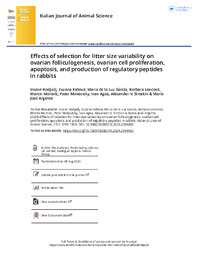Por favor, use este identificador para citar o enlazar este ítem:
https://hdl.handle.net/11000/33937Registro completo de metadatos
| Campo DC | Valor | Lengua/Idioma |
|---|---|---|
| dc.contributor.author | Hadjadj, Imane | - |
| dc.contributor.author | Fabová, Zuzana | - |
| dc.contributor.author | García, Maria de la Luz | - |
| dc.contributor.author | Loncová, Barbora | - |
| dc.contributor.author | Morovic, Martin | - |
| dc.contributor.author | Makovicky, Peter | - |
| dc.contributor.author | Agea, Iván | - |
| dc.contributor.author | Sirotkin, Alexander V. | - |
| dc.contributor.author | Argente, Maria Jose | - |
| dc.contributor.other | Departamentos de la UMH::Tecnología Agroalimentaria | es_ES |
| dc.date.accessioned | 2024-11-20T08:21:17Z | - |
| dc.date.available | 2024-11-20T08:21:17Z | - |
| dc.date.created | 2024 | - |
| dc.identifier.citation | ITALIAN JOURNAL OF ANIMAL SCIENCE 2024, VOL. 23, NO. 1, 1290–1304 | es_ES |
| dc.identifier.uri | https://hdl.handle.net/11000/33937 | - |
| dc.description.abstract | The present study aimed to identify the novel mechanisms regulating rabbit fecundity. For this purpose, the association between litter size variability, fecundity, ovarian morphology, and markers of proliferation, apoptosis, steroidogenesis, and the presence of regulatory proteins were examined in ovarian cells from two rabbit lines divergently selected for low (LL) and high (HL) variability in litter size throughout sixteen generations. Ovaries and uteri were isolated from multiparous non-lactating female rabbits from each line at sixteen generations of selection. One part of the ovary was subjected to histomorphometric analysis of folliculogenesis. From the rest of ovary, ovarian granulosa cells (OGCs) were isolated, cultured, and cell viability, proliferation (accumulation of PCNA and of cyclin B1, and BrdU-positive cells), and apoptosis (accumulation of caspase 3, bax and DNA fragmentation) were evaluated by the Trypan blue exclusion test and BrdU, quantitative immunocytochemistry, and cell death detection assays. Furthermore, OGCs were subjected to proteomic analysis by using the nano HPLC-Chip-MS/MS method. The release of progesterone and oestradiol was measured by ELISA. The LL had more than one kit per litter than the HL (7.6 kits vs. 6.5 kits, p � 0.05). No differences were found in the diameter of primordial and primary ovarian follicles, theca, and granulosa thickness, but the diameter of oocytes in the primary and secondary follicles was higher in the LL than in the HL (88.49 mm in the LL vs. 77.86 mm in the HL for oocytes of primary follicles, p � 0.05; 122.10 mm in the LL vs. 109.87 mm in the HL for oocytes of secondary follicles, p � 0.05). Preovulatory follicles were pre- sented only in the ovaries of the LL. The LL had higher incorporation of BrdU and reduced accu- mulation of bax within OGCs (0.92% in the LL vs. 0.44% in the HL for incorporation of BrdU, p � 0.05; 41% in the LL vs. 48% in the HL for accumulation of bax, p � 0.05). Ovarian fragments from the LL produced less progesterone and oestradiol than those of the HL (12 ng/mg tissue/ day in the LL vs, 45 ng/mg tissue/day in the HL for progesterone, p � 0.05; 11 ng/mg tissue/day in the LL vs. 30 ng/mg tissue/day in the HL for oestradiol, p � 0.05). Besides, the OGCs from the LL produced a higher number of specific regulatory proteins involved in cell differentiation, pro- liferation, and adhesion than the HL (50 vs 38, p � 0.05). In conclusion, higher prolificacy in the LL line would be caused by: (1) the selection of growing primordial ovarian follicles; (2) better transformation to preovulatory follicles; (3) increased cytoplasmic maturation of oocytes; (4) increased DNA synthesis and decreased cytoplasmic apoptosis in OGCs; (5) changes in ovarian steroidogenesis; and (6) changes in the number of peptides involved in cell differentiation, pro- liferation, and adhesion. | es_ES |
| dc.format | application/pdf | es_ES |
| dc.format.extent | 16 | es_ES |
| dc.language.iso | eng | es_ES |
| dc.publisher | Taylor & Francis Group | es_ES |
| dc.rights | info:eu-repo/semantics/openAccess | es_ES |
| dc.rights | Attribution-NonCommercial-NoDerivatives 4.0 Internacional | * |
| dc.rights.uri | http://creativecommons.org/licenses/by-nc-nd/4.0/ | * |
| dc.subject | Ovary | es_ES |
| dc.subject | hormones | es_ES |
| dc.subject | apoptosis | es_ES |
| dc.subject | proliferation | es_ES |
| dc.subject | cell cycle | es_ES |
| dc.subject.other | CDU::6 - Ciencias aplicadas::62 - Ingeniería. Tecnología | es_ES |
| dc.title | Effects of selection for litter size variability on ovarian folliculogenesis, ovarian cell proliferation, apoptosis, and production of regulatory peptides in rabbits | es_ES |
| dc.type | info:eu-repo/semantics/article | es_ES |
| dc.relation.publisherversion | https://doi.org/10.1080/1828051X.2024.2396482 | es_ES |

Ver/Abrir:
Effects of selection for litter size variability on ovarian folliculogenesis ovarian cell proliferation apoptosis and production of regulatory pept.pdf
2,25 MB
Adobe PDF
Compartir:
 La licencia se describe como: Atribución-NonComercial-NoDerivada 4.0 Internacional.
La licencia se describe como: Atribución-NonComercial-NoDerivada 4.0 Internacional.
.png)